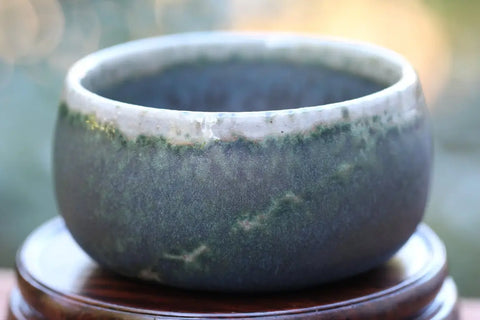
Joie De Vivre: Jun Ci Porcelain 钧瓷
Perhaps no time in Chinese history was more vibrant than that during the Song Dynasty, which lasted from the 10th to the 13th centuries. During this period, China experienced an intellectual revolution, flourishing in subjects as diverse as philosophy, literature, mathematics, engineering, law, military strategy, poetry, and cuisine.

With the citizenry relatively vibrant and the economy wealthy, it’s perhaps no wonder that some of the most important methods in ceramics, and by extension, functional works of art, were birthed during this era as well. After all, artists had the leisure to experiment and patrons had the means to support their endeavors.
Indeed, it was the Song Dynasty that would give rise to what we now call the Five Famous Kilns: Ru Kiln, Imperial Kiln, Jun Kiln, Ge Kiln, and Ding Kiln. Of these, it was Jun Ci porcelain that had a tendency to be vibrant and rich in color, boasting everything from lush rose purples and crimson reds to calming sky blues and aquamarines.
The mélange of colors characteristic of Junware is owed, in part, to the copper oxide in the Jun glaze, which can range anywhere from green to red, depending on whether the kiln is in an oxidation or reduction atmosphere.

This wide variation of color, which was sensitive to the slightest changes in temperature, added an element of chance to the finished product. This whimsy was precisely one of the things that made Jun Ci so desirable. To this day, no two pieces of Jun porcelain are the same.
What is even more fascinating about the color of Jun ware is that the blue in a piece of true Jun porcelain is actually not the color of the glaze but an optical effect created by the way that the pottery was fired.

In a high temperature environment, usually between 1300 °C – 1380 °C, the glaze separates into small glass-like droplets that scatter blue light, giving the Junware its characteristic blue color. Scientifically, this is known as Rayleigh scattering, and it is the same principle that makes the sky look blue to us. It’s kind of amazing to consider that the same thing that makes the sky blue is what gives Jun teaware its color.
It’s difficult to put into words how Jun porcelain manages to both animate and inspire. It seems to embody and reflect a certain kind of joie de vivre, a quality made all the more salient when one collects a piece that can be used.
Perhaps the paradigm experience of the marriage of art and function is when one sips artisanal single origin loose leaf tea from a Jun Ci tea cup. The tea just seems to delight in this brilliant display of color, inviting one to see the joy awaiting them beyond the daily demands of the day.
Fortunately, this is something we at MeiMei Fine Teas believe wholeheartedly, and so we have searched high and low to carefully curate contemporary pieces of Jun Ci porcelain that share in that resplendent and invigorating Song aesthetic.
We hope that you can find a piece that brings that same level of joy to your hearts, especially with the Holiday Season upon us.